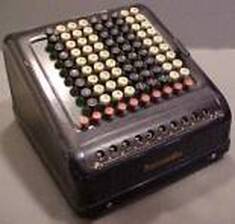
Key-driven and Electric Calculators
This group of machine are calculating machines comprising all non-printing (listing) machines. Typically called Key Driven Calculators at Burroughs.
The first machines of this type were built by Dorr E. Felt and marketed by the Felt and Tarrant Manufacturing Company for many years. Called the Comptometer by Felt, Burroughs referred to this type machine as the key-driven calculator.
The key-driven type machine did not print, and while it was often used as an adding machine, it developed into a special purpose machine in later years. The machine was exceedingly fast and experienced operators could easily outrun an operator on a full keyboard or 10-key adding machine. The efficient operation of these machines required an experienced operator who often received a high salary.
These machines was produced over a very long period because of its unique capabilities and were most often used to verify product delivery lists from delivery routes, such as home dairy delivery, where extending totals was a repetitive task.
Later models of the machine, called a duplex design, could hold a running total in a second set of dial wheels while the primary wheels continued to add and subtotal amounts that could be transferred at any time to the running total.
A side note, Burroughs copied the Felt design for its first models and was sued for patent infringement by Felt and Tarrant, who prevailed in the suit. As a result, Burroughs totally redesigned their machine and went on to compete with the Felt machine for decades.
One more note of interest about these machines is the building of a very large capacity model (40 columns) by Burroughs called the "Duodecillion Calculator". A fellow collector, Lawrence Greenall, provided me with some links to information about this special production model. Thanks to Lawrence, the information is available to review on the following linked sites:
https://www.rechnerlexikon.de/artikel/Duodecillion
https://en.wikipedia.org/wiki/Mechanical_calculator#/media/File:Duodecillion.jpg
https://www.abebooks.com/paper-collectibles/What-Duodecillion-vintage-Burroughs-Calcuator-advertisement/31580364155/bd#&gid=1&pid=2
https://de.wikibooks.org/wiki/Datei:Duodecillion_Comptometer.jpg
This group of machine are calculating machines comprising all non-printing (listing) machines. Typically called Key Driven Calculators at Burroughs.
The first machines of this type were built by Dorr E. Felt and marketed by the Felt and Tarrant Manufacturing Company for many years. Called the Comptometer by Felt, Burroughs referred to this type machine as the key-driven calculator.
The key-driven type machine did not print, and while it was often used as an adding machine, it developed into a special purpose machine in later years. The machine was exceedingly fast and experienced operators could easily outrun an operator on a full keyboard or 10-key adding machine. The efficient operation of these machines required an experienced operator who often received a high salary.
These machines was produced over a very long period because of its unique capabilities and were most often used to verify product delivery lists from delivery routes, such as home dairy delivery, where extending totals was a repetitive task.
Later models of the machine, called a duplex design, could hold a running total in a second set of dial wheels while the primary wheels continued to add and subtotal amounts that could be transferred at any time to the running total.
A side note, Burroughs copied the Felt design for its first models and was sued for patent infringement by Felt and Tarrant, who prevailed in the suit. As a result, Burroughs totally redesigned their machine and went on to compete with the Felt machine for decades.
One more note of interest about these machines is the building of a very large capacity model (40 columns) by Burroughs called the "Duodecillion Calculator". A fellow collector, Lawrence Greenall, provided me with some links to information about this special production model. Thanks to Lawrence, the information is available to review on the following linked sites:
https://www.rechnerlexikon.de/artikel/Duodecillion
https://en.wikipedia.org/wiki/Mechanical_calculator#/media/File:Duodecillion.jpg
https://www.abebooks.com/paper-collectibles/What-Duodecillion-vintage-Burroughs-Calcuator-advertisement/31580364155/bd#&gid=1&pid=2
https://de.wikibooks.org/wiki/Datei:Duodecillion_Comptometer.jpg

Class 5 Electric – Non-listing, key-driven, calculating machines with electric key-actuation and clearing. These machines include both simplex (one register) and later duplex (two register machines). Additionally, a simplified subtract method was introduced on the simplex electric machines in 1936.
Date Range -- 1928-197x
Original Price -- $200-$300
Today’s Value -- $50-$150





